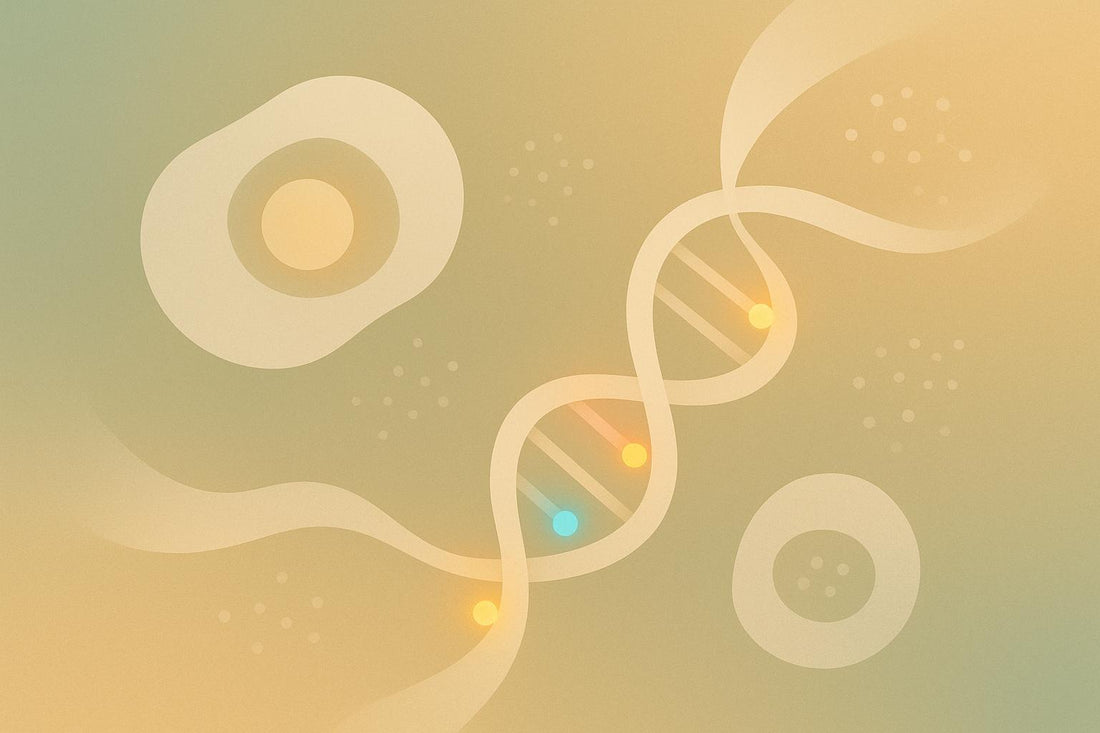DNA methylation is a key process that influences how we age and how long we live. It involves adding a methyl group to DNA, which can turn genes "on" or "off" without changing the DNA itself. Here's what you need to know:
- Aging Patterns: As we age, DNA methylation patterns change - some areas lose methylation (hypomethylation), while others gain it (hypermethylation). These changes can impact gene regulation and are linked to age-related diseases.
- Measuring Biological Age: Scientists use "DNA methylation clocks" to estimate biological age more accurately than traditional methods. Examples include the Horvath Clock and GrimAge, which predict aging and health risks.
- Improving Methylation: Lifestyle factors like diet, exercise, sleep, and stress management can positively influence DNA methylation. Supplements like NMN, resveratrol, and spermidine also support healthy methylation.
- Reversing Aging: Emerging research shows that targeted interventions, including epigenetic reprogramming, may reverse some age-related methylation changes.
Quick Overview of DNA Methylation Clocks
| Clock | Focus | Accuracy |
|---|---|---|
| Horvath Clock | Works across tissues | Error under 5 years |
| Hannum Clock | Blood-specific analysis | Error under 5 years |
| PhenoAge | Health and mortality prediction | Improved accuracy |
| GrimAge | Tracks mortality and smoking risk | Strong health links |
DNA methylation offers a window into the aging process and opens doors to interventions that can slow or even reverse biological aging.
Steve Horvath on Epigenetics, Aging, and Reversing the Biological Clock | WIRED Health
DNA Methylation Basics
DNA methylation is a fascinating epigenetic process that helps regulate gene expression without altering the DNA sequence itself [4]. It works by adding a methyl group to cytosine molecules, creating 5-methylcytosine (5mC). Interestingly, 5mC makes up about 1% of nucleic acids in the human genome [2].
How Methylation Controls Gene Activity
Now that we’ve covered the basics, let’s dive into how DNA methylation influences gene activity. Think of it as a molecular switch. When methyl groups attach to gene promoters, they often suppress gene transcription [4]. This mechanism plays a key role in several biological processes, including:
- Silencing retroviral elements
- Regulating tissue-specific gene expression
- Controlling genomic imprinting
- Driving X chromosome inactivation
Methylation achieves this regulation through two primary methods:
- Recruiting proteins that inhibit gene activity
- Preventing transcription factors from binding to DNA [2]
"The dynamic change between methylation and demethylation states introduces flexibility to the rigidly stable DNA code, allowing controlled changes in gene expression in response to external and internal environmental cues." – Yasmeen Salameh, Yosra Bejaoui, Nady El Hajj [1]
Age-Related Methylation Changes
As we grow older, the patterns of DNA methylation in our genome shift significantly. Here’s how these changes typically manifest:
| Methylation Change | Location | Impact |
|---|---|---|
| Hypomethylation | Global genome | Reduced efficiency in gene regulation |
| Hypermethylation | CpG islands | Improper silencing of certain genes |
These shifts highlight the dynamic nature of methylation as we age. Research has uncovered some striking findings:
- Studies on identical twins reveal that younger twins have nearly identical methylation patterns, while older twins show more pronounced differences in their methylomes [3].
- An analysis of 217 human tissue samples from 10 different anatomical sites found that regions outside CpG islands tend to lose methylation with age, whereas CpG islands gain methylation [3].
- Embryos exhibit the highest levels of 5-methylcytosine, which gradually decrease over a lifetime [5].
Environmental factors - like diet, physical activity, and exposure to pollutants - also shape methylation patterns. On top of that, age-related metabolic changes, particularly those affecting one-carbon metabolism, can disrupt the body’s ability to maintain proper methylation levels [5].
These shifts in methylation patterns over time have opened doors to new ways of measuring biological age and developing targeted interventions.
Measuring Age Through Methylation
DNA methylation patterns have become essential tools for estimating biological age. They offer a more precise alternative to traditional methods, providing insights into how our bodies age at a molecular level.
DNA Methylation Clock Methods
DNA methylation clocks focus on specific CpG sites in the genome that change predictably with age. These clocks achieve impressive accuracy, with correlation coefficients exceeding 0.90 [9]. This approach has transformed how biological age is measured.
| Clock Type | CpG Sites | Key Features | Accuracy |
|---|---|---|---|
| Horvath Clock | 353 | Works across multiple tissues | Error under 5 years |
| Hannum Clock | 71 | Blood-specific analysis | Error under 5 years |
| PhenoAge | 513 | Focuses on health indicators | Improved mortality prediction |
| GrimAge | 1,030 | Tracks mortality and smoking markers | Strong link to health outcomes |
"These 'epigenetic clocks' link developmental and maintenance processes to biological ageing, giving rise to a unified theory of life course."
– Nature Reviews Genetics [6]
Research shows that when DNA methylation age exceeds chronological age by five years, the risk of mortality increases by 16%, even when adjusted for factors like age, sex, and other health variables [7]. This level of precision allows for real-time monitoring of aging and helps evaluate strategies aimed at improving longevity. These clocks have become key tools for understanding how aging unfolds.
Using Clocks to Track Aging
Building on these established methods, methylation clocks now allow for continuous tracking of aging and the assessment of anti-aging interventions. Clocks like Horvath, Hannum, PhenoAge, and GrimAge demonstrate high accuracy, with errors consistently under five years and strong links to health outcomes [10].
Different clock types specialize in distinct aspects of aging:
- Predicting chronological age
- Assessing mortality risks and health outcomes
- Measuring the pace of epigenetic aging
Newer generations of these clocks refine their focus, emphasizing health outcomes and the rate of biological aging. While they represent a major step forward in aging research, they are best used alongside traditional clinical biomarkers rather than as standalone tools [8]. Their real strength lies in providing a deeper understanding of the biological processes behind aging and in evaluating the impact of longevity-focused interventions.
sbb-itb-4f17e23
Methods to Improve DNA Methylation
Research highlights several strategies that can positively influence key epigenetic markers, contributing to healthier aging.
Diet and Lifestyle Effects
Regular physical activity has been shown to improve gene expression and influence the methylation of specific genes. For example, studies reveal that consistent exercise can lower the risk of Alzheimer's disease by as much as 45% [11][13].
"We are now exposed to chronic stress and chronic sources of inflammation. This is how the Functional Medicine paradigm can help clinicians: not by trying to stop inflammation and stop stress as the drivers of chronic disease, per se, but to help the patient change the way they're living and change their environment away from an inflammatory environment. Evidence is emerging that positive experiences create a positive milieu in the patient, which promotes health and wellness, including and especially the health of the immune system." [12]
Incorporating specific lifestyle interventions can further support healthy methylation patterns:
| Intervention | Benefits | Implementation |
|---|---|---|
| Sleep Optimization | Reduces stress-related methylation changes | Aim for 7–9 hours of quality sleep each night |
| Stress Management | Encourages healthy methylation patterns | Practice mindfulness or relaxation regularly |
| Physical Activity | Slows biological aging processes | Engage in 150 minutes of moderate exercise weekly |
| Social Connection | Boosts markers of overall wellness | Maintain regular social interactions |
While lifestyle adjustments are crucial, certain supplements can also enhance DNA methylation processes.
Supplements for Methylation Support
Several compounds have been identified for their role in supporting healthy DNA methylation:
- NMN (Nicotinamide Mononucleotide): A precursor to NAD⁺, which is essential for energy production, DNA repair, and regulating aging. MASI Longevity Science offers NMN supplements produced in Germany and tested in Switzerland, designed to support cellular renewal and methylation processes [14].
- Resveratrol: Known for activating sirtuins, this compound helps protect DNA and regulate gene expression [14][15].
- Spermidine: Encourages autophagy and cellular renewal, with studies showing it can extend median lifespan in test subjects [14].
- TMG (Trimethylglycine): Supplies critical methyl groups necessary for DNA methylation [14].
By combining these supplements with lifestyle changes, individuals can establish a strong foundation for more advanced interventions.
New Treatment Approaches
Building on these foundational strategies, cutting-edge epigenetic reprogramming techniques offer exciting possibilities for reversing aging markers. For instance, Life Biosciences is preparing an FDA application for the first human trials of cellular reprogramming. Their work on optic nerve stroke treatment has already shown promising results, restoring vision in preclinical studies through partial cellular reprogramming [16].
Daniel Ives, CEO of Shift Bioscience, underscores the importance of this progress:
"The epigenetic aging clock is the measure that gives us the most confidence that we are either successfully or unsuccessfully intervening in the physiological aging process." [17]
The field is advancing rapidly, with significant investments like Altos Labs’ $3 billion initiative launched in January 2022, aimed at developing safe and effective therapies for age-related conditions [16].
Conclusion
DNA methylation plays a crucial role in aging and offers opportunities for targeted interventions. Research reveals that around 2% of CpG sites undergo age-related changes, and anti-aging strategies can reverse or prevent 20–40% of these changes [18].
One of the most compelling aspects of DNA methylation is its reversibility. For example, a 2023 study demonstrated that an 8-week program could reduce biological age by 4.60 years [20]. This highlights the potential for interventions to not only slow down aging but actively turn back the biological clock.
MASI Longevity Science provides science-backed supplements designed to support DNA methylation and promote cellular renewal. These interventions aim to improve individual health and longevity while also delivering broader societal benefits. For instance, extending the average healthspan by just one year could save $38 trillion, and a 10-year extension could result in savings of up to $367 trillion [20]. Considering that 60% of U.S. adults live with at least one chronic disease [20], addressing DNA methylation could be a key strategy in improving public health outcomes.
Dr. Jessica Faul offers a balanced perspective on the topic:
"DNA methylation is a robust predictor of later life outcomes, but does not take away the importance of social and demographic and health behaviors in predicting those outcomes... It's a piece of the puzzle, but only a piece of it." [19]
These findings emphasize the potential of epigenetic interventions to not only extend life but also enhance its quality by focusing on healthy aging.
FAQs
How do diet and exercise impact DNA methylation and the aging process?
Diet and exercise have a powerful impact on DNA methylation - a critical process linked to aging and longevity. Regular physical activity can shift methylation patterns in tissues like muscle and fat, which helps reduce inflammation, boost metabolism, and decrease the likelihood of chronic diseases. Over time, these adjustments can promote healthier aging.
On the dietary side, eating nutrient-packed foods - especially those rich in fruits, vegetables, whole grains, and sources of folate, vitamins B6 and B12, and polyphenols - can encourage positive DNA methylation. This may help slow down biological aging and support long-term health. Pairing a balanced diet with regular exercise strengthens your body's natural ability to age well and stay vibrant.
What are DNA methylation clocks, and how do they measure biological age?
DNA methylation clocks are fascinating tools designed to estimate your biological age by examining specific DNA methylation patterns. These chemical modifications to your DNA occur naturally and shift in predictable ways as you grow older. Because of this, they serve as a reliable marker for gauging how your body is aging, which may not always align with your chronological age.
A prominent example of this is the Horvath clock, which measures methylation across multiple DNA sites to provide a detailed estimate of biological age across different tissues. While these clocks excel in analyzing blood samples, their accuracy can vary when applied to other tissues, often requiring fine-tuning for the most precise results. Beyond just tracking the aging process, DNA methylation clocks can shed light on overall health and potential risks for age-related conditions.
By understanding and keeping an eye on DNA methylation, you can take steps to support healthier aging. For those looking to enhance their cellular health, MASI Longevity Science offers high-quality, research-driven supplements aimed at targeting key aging processes and promoting vitality.
Can changes in DNA methylation be reversed to promote healthy aging and longer life?
Yes, studies have shown that DNA methylation changes can be reversed, opening up intriguing possibilities for promoting healthy aging and extending longevity. DNA methylation, an important epigenetic mechanism, is shaped by factors like diet, lifestyle, and environmental influences. By addressing these elements, it may be possible to reverse some age-related methylation patterns, potentially rejuvenating cellular functions and enhancing overall well-being.
New therapies are also emerging, including small molecule treatments and gene editing techniques, aimed at restoring youthful gene expression and tackling age-related conditions. These developments point to the potential not just to slow down aging but to reverse certain aspects of it, offering groundbreaking approaches to improving longevity.




